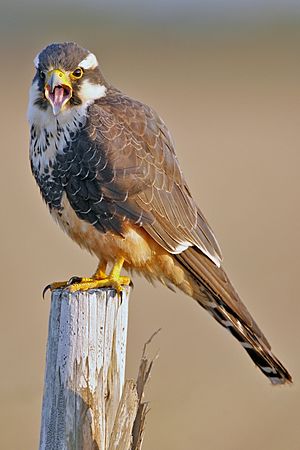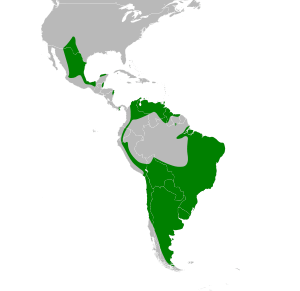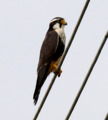Aplomado falcon facts for kids
Quick facts for kids Aplomado falcon |
|
|---|---|
 |
|
| Conservation status | |
| Scientific classification | |
| Genus: |
Falco
|
| Species: |
femoralis
|
 |
|
The aplomado falcon (Falco femoralis) is a medium-sized falcon that lives in North and South America. You can find most of them in South America, but not deep inside the Amazon rainforest.
This falcon used to be called Falco fusco-coerulescens. But now, scientists believe that name actually belongs to the bat falcon. The aplomado falcon looks a bit like a hobby falcon, which is why it was sometimes called the orange-chested hobby.
The word "Aplomado" comes from an old Spanish word meaning "lead-colored." This refers to the blue-grey parts of the falcon's feathers. In Spanish, people call it halcón aplomado or halcón fajado (which means "banded falcon" because of its markings). In Brazil, it's known as falcão-de-coleira.
Contents
About the Aplomado Falcon
What Does It Look Like?
The aplomado falcon is a slim bird with long wings and a long tail. It's about the size of a small peregrine falcon, growing to 12–16 inches (30–40 cm) long. Its wingspan is about 36 inches (90 cm).
Males weigh about 7.3–10.8 ounces (208–305 g). Females are a bit heavier, weighing 9.6–16 ounces (271–460 g).
Adult falcons have dark blue-grey feathers on their upper body and head. They have a clear "moustache" stripe on their face. This stripe stands out against their white throat and a white line near their eye.
Their upper chest is white, like their throat. They have black patches on each side of their lower chest. These patches meet in the middle. Below the black patches, their belly and thighs are a light cinnamon color. Their tail is black with thin white or grey stripes and a white tip. The skin around their beak (called the cere), eye-ring, and feet are yellow or yellow-orange.
Female aplomado falcons look just like males, but they are larger. Young falcons look similar to adults. However, their upper parts and belly band are brownish-black. Their chest has black streaks. The white parts on their head and chest are more yellowish-white. Their cinnamon underparts and feet are also paler.
Similar Birds
Sometimes, people might confuse the aplomado falcon with the bat falcon or the orange-breasted falcon. These birds have similar white, black, and rust-colored patterns on their undersides. But the bat falcon and orange-breasted falcon are built more like peregrine falcons. They also have solid blackish heads and darker reddish-brown bellies.
Other falcons in the Americas, like the merlin and the American kestrel, are also related to the aplomado falcon.
Where They Live and What They Eat
Habitat and Range
Aplomado falcons like dry grasslands, savannahs, and marshes. In Brazil, you can even see them in some big cities like São Paulo. They live from northern Mexico and Trinidad all the way to southern South America.
However, they have disappeared from many places where they used to live. This includes most of northern and central Mexico. Even so, because they are found in so many different places around the world, the IUCN lists them as a species of Least Concern. This means they are not currently in danger of disappearing completely.
What Do They Eat?
Aplomado falcons mostly eat large invertebrates (like insects) and small vertebrates (like small birds). Small birds are their favorite food. If small birds see an aplomado falcon, they get very scared and alert.
You might see these falcons flying around at sunset. They hunt insects in the air and eat them while flying. They also hunt near fields that are being burned. Many falcons might gather there to catch animals trying to escape the fire. Sometimes, two aplomado falcons, usually a pair, will even hunt together.
In Brazil, these falcons have been seen following maned wolves. They chase after birds that the wolves scare out of hiding. The prey they catch usually weighs about one-fifth to one-half of the falcon's own weight. But sometimes, larger female falcons have caught birds bigger than themselves. This includes birds like a cattle egret or a plain chachalaca.
Nests and Young
Aplomado falcons build their nests from sticks. They make a platform in a bush or tree at any height. Female falcons usually lay two or three eggs.
Bringing Them Back to the United States
Until the 1950s, aplomado falcons lived in the southwestern United States. Now, people are working to bring them back to West and South Texas. In the 1990s, they started to return to their old homes in West Texas and southern New Mexico.
In 1991, people found proof of these wild birds in New Mexico. More and more sightings happened over the next ten years. In 2002, three young falcons successfully left their nest there. Sightings and nesting continue today.
Adding special nesting platforms in South Texas has helped the falcons have more babies. This has created a stable population. However, without these platforms, the reintroduced falcons might not survive.
Some groups are worried about how the reintroduction program is expanding. This is because falcons in New Mexico are considered part of an "experimental" group. This means they are protected from hunting. But they don't have the same habitat protection that other endangered species get. Many believe that losing their habitat caused the falcons to almost disappear from the U.S. Environmental groups are trying to get full protection for them. This would help the wild population grow and make the reintroduction efforts more successful.
Aplomado Falcons and Falconry
Hunting with Falcons
Like the merlin, the aplomado falcon is good at chasing small birds and quail. They fly after their prey once it's scared out of hiding.
Because they are rare in the United States, most falconers get them from special breeders. In Europe, a pair of these falcons can cost around £4000. People admire them because they hunt like an accipiter, which is another type of bird of prey. This means they are very determined to catch their prey, even if it hides in thick bushes.
Aplomado falcons are great for hunting quail and doves. Sometimes, they will even go after squirrels or rabbits. One challenge with these smaller falcons is that they sometimes try to fly away from the falconer with their catch. They can hunt anything from small sparrows to adult pheasants. One of the hardest birds for an aplomado falcon to catch is the partridge, because partridges are strong, fast, and can fly long distances.
See also
 In Spanish: Halcón aleto para niños
In Spanish: Halcón aleto para niños
Images for kids
-
Illustration from Pacific Railroad Surveys





